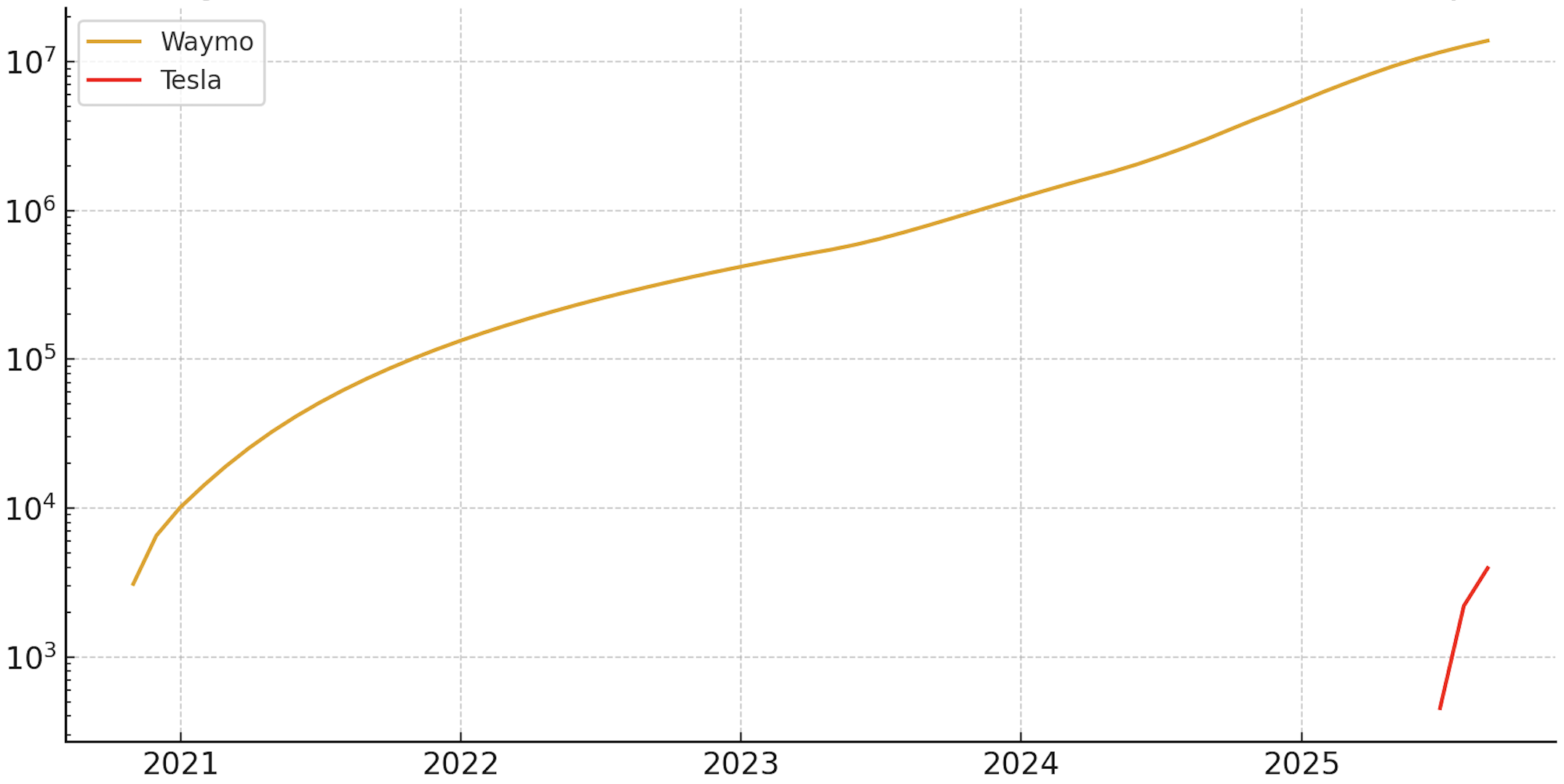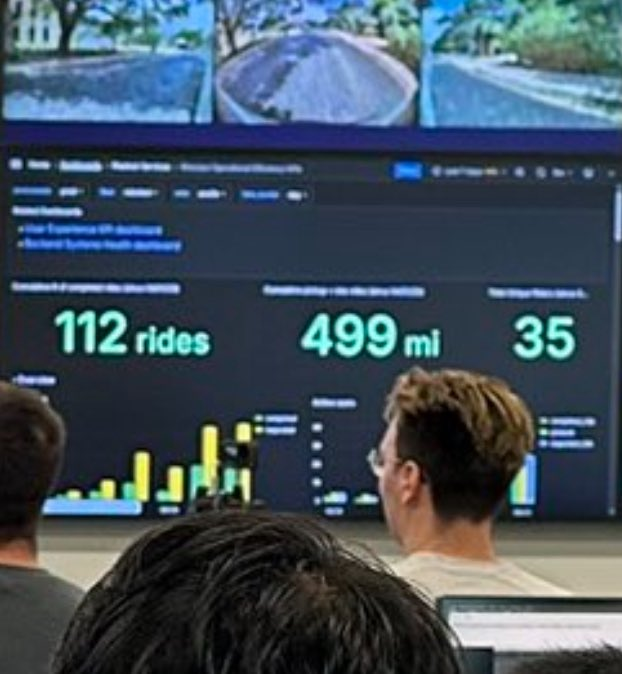NOTE: This market includes any autonomous ride in a Tesla, not just the robotaxi service!
Waymo claims 700k fully autonomous rides in 2023, which was more than ~0 Tesla rides that were fully autonomous in 2023.
To define fully autonomous, I'll use the simplest definition which is that no human operated any direct controls inside the vehicle like the steering wheel or pedals. (UPDATE: And no human in the driver's seat is actively monitoring the driving being ready to intervene.) A ride must be of a non-trivial distance (e.g. crossing the parking lot does not count). Rides on a track like the Las Vegas Loop do not count.
I will delay resolution until both companies report results or until the result is extremely clear, or until it's January 2027, where I'll make an informed guess.
🏅 Top traders
| # | Name | Total profit |
|---|---|---|
| 1 | Ṁ25,241 | |
| 2 | Ṁ18,309 | |
| 3 | Ṁ12,949 | |
| 4 | Ṁ10,636 | |
| 5 | Ṁ5,330 |
People are also trading
By any definition, this question resolves NO.
If you bet for Waymo, please continue betting in the followup 2026 market to match my massive open offer at 50%: https://manifold.markets/JamesGrugett/tesla-serves-more-fully-autonomous
@JamesGrugett Thanks for running this and for being bold in your predictions! Looks like you created this market way back in May 2024. I was quite sure Musk was full of shit on vision-only self-driving back then and still sure a year later. But now I'm no longer so sure. I'm debating how hard I want to bet NO in the 2026 version. That one should be exciting and, as always, I'll be excited to be wrong on this. I'm still a huge Waymo fan though and am rooting for them even harder.
Here's a very unvetted graph from GPT-5 that has some chance of giving a sense of the horse race here:

(One big caveat is that there's currently a 94% chance that none of the Tesla robotaxi rides count at all so far.)
@HankyUSA Seems like Marques wanted the robo taxi to be bad but since it wasn’t he just put up a whatever video with zero emotion
Uber does 23 million rides/day in the US. Austin is 0.7% of US population, let’s say 2% of Uber rides, that’s 460k Uber rides per day.
Let’s say Waymo will have 15 million rides this year and Tesla has ~0 so far. To beat Waymo, Tesla needs to average over 100k rides/day or basically take over 25% of Uber traffic in Austin? Seems pretty unlikely to me. And every day they wait without scaling massively, that number goes up.
@dominic OP is counting private fully autonomous rides as well and is betting on that, afaik. That would obviously scale way faster due to existing vehicles and production infrastructure but also hinges on camera-only being reliable enough and approved by regulators pre-2026. Or they will "guess" 90% of teslas private miles were autonomous in which case I'll lose a shit ton of mana 😃
Yeah, I guess they could approve FSD unsupervised and get past 15 million trips. Though even that would still take ~a month or so. But I think the chance of that happening seems really low (<5%)
@tobiasscheuer @dominic Hmm, yeah, the path is either:
1. Regulators allow unsupervised driving in some states
2. Tesla defacto implements unsupervised self driving by stopping it from nagging you when you stop paying attention
3. Tesla succeeds in massively scaling the robotaxi service (they claim access to half the US population by end of year)
None of these are particularly likely. I consulted AI and got ~5% chance, so it's possible this market is overpriced.
However, there are some crazy trends here, like the increasing billions of FSD miles logged, miles per engagement "doubling every month", and the debut and rapid expansion of service in Austin.
If in 1-2 months FSD is near flawless, and 3 million Tesla owners use it daily and see it works for themselves, lots of things seem possible, including regulators moving faster ("legalize unsupervised to save lives!"), or owners taking matters into their own hands to get the cars to perform fully autonomous rides, or Elon defacto allowing it, risking lawsuits.
@JamesGrugett the link you sent for doubling miles shows FSD got worse with the last update and the entire article is written with a thousand "ifs" by @brianwang, the second biggest Tesla fanboy behind the Tesla Bull @MolbyDick himself. I don't want to rely on ad-hominem attacks even when ignoring Musks PR hype since 2013, so where is the data? The robotaxis are driving in Austin since 1 month, have we seen massive scaling or stagnation? Afaik we don't even have official data how many miles they've driven in Austin so far
EDIT: apparently teslas CFO said 7000 miles autonomously since June. 10 cars. In my opinion, that's not a lot
Some relevant discussion in the 2026 version of this market: https://manifold.markets/JamesGrugett/tesla-serves-more-fully-autonomous
Mainly that the Tesla robotaxis seem to be doing very few miles per day, which updates my probability downward on this market especially.
35 cars in Austin. 112 rides in the first hour or so. $4.20 per ride in the starting phase. It is non-trivial distances. The geofenced area is about 6-7 miles wide by 2-3 miles. 100 rides per hour. likely 1000 rides in the first day (over about 10 hours). up to 6-7 mile rides and average 4-5 miles. Should have 10,000 to 20,000 rides over 9 days but with 18 hours per day. They are shutting down for 6 hours at night. Safety monitor will come out. A market should be made about when the safety monitor comes out. 700 cars with half of the rides per car and 24 hour operation would be about 200,000 rides per day.
Wells Fargo estimates 18 million rides for Waymo in 2025. Need 100 days at 200k rides per day for Tesla to get 20 million rides in 2025. Getting to 1000 active robotaxi would make that possible but having 3k or more in Q4 should do it.


@brianwang My avatar is what your 3rd grade math teacher would do if they saw this comment. 200K rides per day with 700 cars is 12 rides per car per hour.
And until the safety monitor is gone, none of the rides will satisfy the question's conditions. They have access to some buttons on the screen that obviously qualify as interventions.
@JamesGrugett Are you buying yes based on a belief that this is already true in H1? Or that the product branded "FSD (Supervised)" will improve/rebrand in H2 such that fewer drivers feel the need to actually supervise?
For example this crash suggests that the ride was de facto unsupervised (EDIT: I was too credulous, the user released CAN data which shows a disengagement before it veers off the road, likely them steering left without knowing, but it still indicates low/absent quality of supervision) - presumably this owner has clocked a few "fully autonomous" rides up to this point, right? Or would you say such rides are not autonomous, for example because it looks dumb in hindsight to trust software that makes that mistake?
@fwbt I think that by my definition there certainly have been some autonomous rides, just not that many. I expect it to rise exponentially in the latter half of this year
@JamesGrugett does it count as fully autonomous if the human in the driver's seat is supposed to be supervising but just neglects to do so?
To me it's not fully autonomous unless a blind person could sit in the driver seat.
@HankyUSA I agree generally, but the criteria here is to count each individual ride that was autonomous, so yes it would count. Think of each autonomous ride as some small evidence that it's getting closer to working.
It's possible that Tesla could have many negligent autonomous rides, but I doubt that would be enough to beat Waymo. They have to make it actually work.
@JamesGrugett how do you know there have been any such rides? As far as I can tell all the ‘autonomous’ rides have been monitored both remotely and inside the car.
@MachiNi Everything is stated the market description. Autonomous rides can include random people who didn't use the controls when driving in their own Tesla. Yes, we don't have an exact count of those, but if we need to, we can make an estimate.
@JamesGrugett so remote monitoring and safety driver in the passenger seat are compatible with autonomy? If so then my question is how that will be counted. Do you have a source? Would you count statements by Musk as a company report?
@MachiNi I suspect this won't matter in this market since presumably Tesla will need to ditch the safety monitors as part of catching up to Waymo but it would be good to pre-decide how these initial quasi/ambiguously-supervised rides should be counted just in case. I think we're doing a great job of figuring out the fairest way to answer that in my own market about this.
@dreev It's a good point. It's surprising how much gray area there is to what constitutes an autonomous ride.
I think the closest interpretation to my original market description is that it would count if the safety driver is not in the driver's seat.
The question is about rides that get completed without intervention. Even Waymo has remote operators that can intervene for issues. So if the Tesla drives from point A to point B without intervention, and especially if the safety driver in the passenger seat is not capable of rapidly intervening, then I think this counts as an "autonomous ride", which is distinct from perfect autonomy.
(E.g. "those cars are fully autonomous" is a different claim than "that one ride was fully autonomous") Counting the number of "autonomous rides" is still a good methodology for determining full autonomy IMO.
@JamesGrugett not counting anyone in the passenger’s seat is fine with me, since you’re making it explicit.

